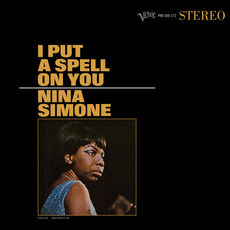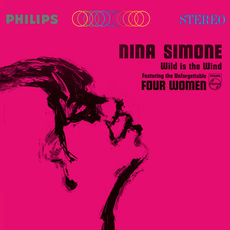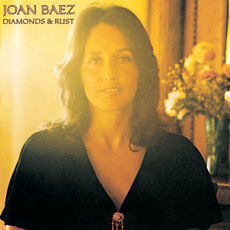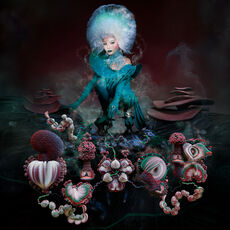Explore the rich legacy of female artists who have shaped music history with their writing, melodies, and social activism. Since the dawn of time, whether highlighted or not, women have had a significant impact on the world of music, despite the challenges they have and continue to face. Take a deep dive with us and celebrate women’s voices throughout time, from Joan Baez to Björk, from Nina Simone to Rina Sawayama through Patti Smith, k.d. lang and beyond. In a still male-dominated industry, each of these artists has crafted their own musical legacies, fought for their beliefs, and weren’t afraid to run up that hill.
Nina Simone
Nina Simone, born in 1933, is remembered as the “high priestess of soul,” her legacy enduring decades. Initially trained as a classical pianist, Simone faced rejection from the Curtis Institute of Music, something she always felt was a case of racial discrimination, which had a profound impact on her. Despite early success with her debut album Little Girl Blue under Bethlehem Records, she still harbored aspirations of being a concert pianist. However, it wasn’t until her rendition of “I Loves You, Porgy” reached the Top 20 charts in 1959 that she decided to move to New York to pursue her growing fame.
Though often labelled a jazz vocalist, Simone rejected this categorization, seeing it as a dismissal of her diverse musical influences, which spanned folk, gospel, blues, jazz, pop, and classical. Engaging with social and political issues, Simone’s involvement in the Civil Rights Movement intensified after attending the American Society of African Culture conference in Lagos, Nigeria, in 1961. Her iconic protest song “Mississippi Goddam” (1964) was a response to the Sixteenth Street Baptist Church bombing and the assassination of Medgar Evers.
Encountering discrimination in the music industry as a Black woman, Simone’s experiences became the driving force behind her music and activism, as seen in songs like “Four Women” (1966). Her music became a powerful tool for advocating social change, resonating deeply within African American communities, which solidified her legacy as a symbol of Black power and resilience.
I tell you what freedom is to me: no fear - Nina Simone
Joan Baez
Of course, we couldn’t talk about pioneering female musicians without mentioning Joan Baez, a leading figure of the ‘60s folk revival and all-around folk-rock legend. Once describing herself as a human being first, a pacifist second, and a folk singer third, Baez never underestimated the relationship between music and social change. Using her skill as a songwriter and an exceptional ability to transform traditional songs and those written by other artists with an emotional power that is completely her own, she lent her spellbinding soprano voice and masterful vibrato to a range of honourable causes for over 60 years. Perhaps most famously, she sang her version of “We Shall Overcome” at the March on Washington in 1963, a song that would become an anthem of the Civil Rights Movement (and also international protests in later years).
Baez was also jailed for supporting draft resistance during the Vietnam War, performed at concerts protesting the Briggs Initiative in California—which banned openly LGBTQ+ people from becoming teachers—and played the first Amnesty International Tour, to name just a few moments in her unwavering activism. As a recording artist, she sang about these issues in tracks such as “Altar Boy and the Thief” and the experimental “Where Are You Now, My Son?,” which spans over 20 minutes and documents her experience delivering mail to prisoners of war in Hanoi during the Christmas bombings in 1972. No doubt, Joan Baez will go down as an inspirational woman on every level.
Dory Previn
Dory Previn began her career as a lyricist for MGM. There, she began collaborating with composer Andre Previn, earning Oscar nominations for songs used in films like Two for the Seesaw and Pepe. (And as Dory Langdon, she recorded her first album, The Leprechauns Are Upon Me—featuring Kenny Burrell on guitar—during this era.) Eventually, the two became romantically involved, marrying in 1959, and would continue to write music that would be recorded by Sammy Davis Jr., Rosemary Clooney, Tony Bennett, Nancy Wilson, Frank Sinatra, and Bobby Darin, and continue their film work, perhaps most notably for Valley of the Dolls, including the Dionne Warwick-sung theme song.
Andre’s work as a classical music conductor required extensive travel abroad, but Dory’s aviophobia prevented her from joining him and eventually led to a psychiatric breakdown. As a result of her husband’s well-documented affair with Mia Farrow, Dory Previn would experience another breakdown a few years later, for which she was treated with electroshock therapy.
Dory Previn would reemerge in the 1970s as a Laurel Canyon-based singer-songwriter and it’s during this second act that she began to write candidly about everything—her mental illness, her past, her betrayers. “Beware of Young Girls,” from her 1970 solo album, On My Way to Where, addressed her ex-husband and his 25-year-old new bride. Her highly detailed lyrics navigated sexuality and feminism, and expressed a freeness and levity that eluded Previn in her youth, growing up in a strict, Catholic, New Jersey household in fear of her WWI veteran father, himself an unsuccessful musician.
Though lesser-known than contemporaries like Joni Mitchell and Carole King, Previn nevertheless developed a cult following. The Scottish band Camera Obscura honoured her with an eponymous track on their 2006 album, Let’s Get Out of This Country. A documentary about the singer, titled after her 1970 album, premiered at SXSW’s 2024 film festival. Much of her solo catalogue remains, regrettably, widely unavailable on streaming.
Carole King
Carole King was just a teenager when she began working professionally as a songwriter. With her first husband Gerry Goffin, King was famously part of the legendary Brill Building scene—though less known is the fact that the two actually worked a block north at Aldon Music (1650 Broadway). Goffin and King wrote indelible songs like “You Make Me Feel Like a (Natural Woman),” “One Fine Day,” “Will You Love Me Tomorrow?” and “The Locomotion”—a hit for their babysitter, Little Eva.
By her mid-twenties, however, King was a single mother of two young daughters and relocated to Laurel Canyon, the neighbourhood of winding roads in the Hollywood Hills associated with Neil Young, Joni Mitchell, J.D. Souther, the Mamas and the Papas, Graham Nash, and others, all of whom resided there or spent considerable time in the area.
It was in Laurel Canyon that King transformed into a solo artist, breaking through with her second album, 1971′s Tapestry, which would top the charts for a then-record-breaking 15 weeks, and eventually win four Grammy awards, a first for a female artist. It remained the best-selling album by a female artist for the next 25 years.
Younger generations may have been introduced to King through the television show Gilmore Girls. King and her daughter Louise Goffin re-recorded Tapestry’s “Where You Lead” with revised lyrics that changed the point of view to a mother talking to her daughter to serve as its theme song (and she also guest-starred as the town’s music shop owner on several episodes).
Patti Smith
Patti Smith, born in 1946, rose to prominence within the punk rock movement of the 1970s, notably with her seminal debut album Horses in 1975. Demonstrating a distinctive fusion of spoken word and minimalist punk rock accompanied by John Cale’s avant-garde production, Smith fearlessly explored taboo topics such as suicide, poverty, and her own experiences as a female artist.
As one of the rare female figures within a predominantly male-dominated scene, Smith continued to refine her artistic philosophy, releasing Radio Ethiopia in 1976, followed by her most commercially successful album Easter in 1978, featuring the hit single “Because the Night,” co-written with Bruce Springsteen.
Despite a hiatus from music to focus on family, Smith remained steadfast in her politically and environmentally driven convictions. Her return to the stage included notable moments like bringing the Dalai Lama on stage at Glastonbury in 2015 to celebrate his 80th birthday, inspired by their encounter at the World Peace Conference in Berlin in 1995. On one occasion when the two met, the Dalai Lama was asked what’s the number-one thing that young people can do to make a better world, and without hesitation, the Dalai Lama replied: “Look after the environment.”
While Smith didn’t actively participate in feminist movements or explicitly advocate for gender equality, largely due to her long-standing self-identification outside traditional gender categories, her influence as a trailblazer for women is widely acknowledged. Although female musicians like Nina Simone and Joan Baez predated her, Smith’s emergence during the punk rock era marked a significant shift, paving the way for greater gender inclusivity in music.
To me, punk rock is the freedom to create, freedom to be successful, freedom to not be successful, freedom to be who you are. It’s freedom - Patti Smith
Tracy Chapman
Tracy Chapman’s surprise appearance at the 2024 Grammy Awards was a seismic event. The highly private singer-songwriter hadn’t played a full show in 15 years and last appeared on television as a music guest in 2015, when she performed “Stand By Me” on one of David Letterman’s final Late Show episodes. Chapman’s 1988 hit “Fast Car,” from her self-titled debut that year, had recently experienced a second life, and in late 2023, she made history by becoming the first Black woman to win a CMA award of any kind. The sentiment of “Fast Car,” encapsulated so succinctly in its opening verse—”And I want a ticket to anywhere”—gripped an entirely new cohort of music fans. Similarly, thirty-five years prior, Chapman had introduced herself to a global audience of 600 million people in 67 countries in an equally momentous and emotionally resonant way.
During Nelson Mandela’s 70th birthday celebration at Wembley Stadium, a piece of Steve Wonder’s equipment was discovered to be missing, leaving the producers with a time gap to fill. The then 24-year-old Chapman took to the stage with just her acoustic guitar for an unexpected second set that included “Fast Car.” The star-making performance catapulted Chapman to the top of the Billboard 200 charts in the U.S. Chapman would release seven more albums, including 1995′s New Beginning—featuring another hit, “Give Me One Reason”—and 2008′s Our Bright Future, her latest to date. Throughout her career, she remained aligned with political causes like Amnesty International and received a National Order from the South African Presidency in 2023 for “her contribution to the fight for freedom by participating in efforts to free Nelson Mandela and raising awareness of human rights violations globally.”
Sinéad O’Connor
“They tried to bury me, they didn’t realize I was a seed,” proclaimed Sinéad O’Connor in the 2022 documentary Nothing Compares. At just 20 years old, the Irish singer landed with a bang with her debut LP The Lion and the Cobra (1987). Screaming with her shaved head on her sleeve, she instantly impressed people with the combative power of her stunningly haunting voice, tackling difficult topics like the Troubles in Northern Ireland (“Drink Before the War”). Despite her pregnant belly at the time being deemed too subversive and often cut from frame, O’Connor’s unquenchable non-conformism shone through.
In March 1990, her cover of Prince’s “Nothing Compares 2 U” reached number one in 17 countries, catapulting her to international fame. But from boycotting the Grammys in resistance to the Gulf War to speaking at a rally in Dublin for the right to abortion, O’Connor consistently proved she was never destined to be a conventional pop star, but rather carried the torch of Ireland’s long history of using art as protest.
1992 saw her extremely controversial Saturday Night Live performance, where she sang Bob Marley’s “War” and tore up a picture of Pope John Paul II in protest of the child sexual abuse committed by Catholic priests. In response, millions of people across the world publicly expressed hate for her, many even sending death threats to O’Connor and her team. Though many resented her for supposedly throwing away her career, O’Connor had never set out to be a star and continued to make music authentic to her beliefs until 2014′s I’m Not Bossy, I’m the Boss. Sinéad O’Connor, who died of natural causes in 2023, has left a remarkable legacy, her astounding courage making her a spearhead for the politically engaged artists of today.
k.d. lang
Born in Edmonton, Canada, in 1961, singer k.d. lang, began her iconic career in 1983 in a tribute band called The Reclines, dedicated to her idol Patsy Cline. Three years later, with a JUNO award for most promising female vocalist under her belt, she signed with Sire Records, launching her career in the U.S.
Her 1987 duet with Roy Orbison on his 1961 song “Crying” won a Grammy and lang’s success continued to grow with Shadowland (1989) and 1992′s Ingénue. While promoting the latter in an interview with the LGBT magazine, The Advocate, lang publicly came out as a lesbian, at a time when very few musicians dared to do so. Striking a perfect balance between the emotion, glamour, and humour of country, with her style and satiny voice, Ingénue became a queer cornerstone in a genre steeped in American conservatism and featured the sapphic yearning of lang’s biggest ever hit “Constant Craving.” From there her sound continued to expand creatively, bringing in other sonic influences like alt-country, pop and even torch singing on albums from Drag (1997) to her project in collaboration with Neko Case and Laura Veirs, case/lang/veirs (2016).
Throughout her career, lang’s values, androgyny and artistic disregard of tradition shook up Nashville. Alongside advocating against animal cruelty, she continuously championed the rights of the LGBTQ+ community and has carved out a space for queer artists within country music, from Brandi Carlile to Orville Peck.
Lauryn Hill
In the 1990s, Lauryn Hill rose to prominence as a member of The Fugees, but there was more to her story. Ahmir Thompson, drummer of The Roots, revealed that Lauryn’s solo career wasn’t just about making an album; it was about defining herself outside of Wyclef Jean’s shadow. However, the road to the top was never an easy one, especially for a Black woman in the male-dominated rap world.
Her debut album, The Miseducation of Lauryn Hill, gained cult status, ranking #10 on Rolling Stone’s 500 Greatest Albums of All Time. Blending R&B, soul, and hip-hop, Hill fearlessly addressed personal and societal struggles, including racism, sexism, and poverty, challenging norms through her music. Songs like “Black Rage (Sketch)” reflected the turmoil of Ferguson after Michael Brown’s death, while “Freedom Time” urged listeners to awaken to societal norms and fight for justice.
Beyond music, Hill championed her beliefs. She co-founded the Refugee Project in 1996, marched with Black Lives Matter, and organized the Diaspora Calling! festival, celebrating African culture’s global impact. In 2012, she criticized industry racism and sexism on social media, exposing the exploitation of female artists.
Despite her success, Hill constantly faced a barrage of criticism from the media. From tabloid rumours about her personal life to scrutiny over her appearance and behaviour. Eventually, in 2000, she cleaned house, firing her management team and stepping back from the spotlight, disillusioned by an industry that criticized and stifled her creativity. Though she largely retreated from music, Hill’s legacy as a trailblazing musician and fearless advocate for change endures, inspiring countless others to stand up and speak out.
I consider myself a crayon... I may not be your favorite color but one day you’ll need me to complete your picture - Lauryn Hill
Joan Armatrading
Joan Armatrading’s life was forever changed when her mother bought a piano as a piece of furniture: she discovered she was born a songwriter. Born in Saint Kitts in 1950, she spent her early childhood in Antigua before moving to Birmingham, England at the age of 7. By 14 Armatrading was writing songs with the piano and a guitar she acquired in a pawn shop in exchange for two old prams. In 1970, she joined a production of the musical Hair before releasing her first solo album, Whatever’s For Us, two years later.
Throughout the ‘70s and ‘80s, with her winning combination of pop, rock and blues influences, heartfelt lyrics and rich contralto voice, Armatrading grew in popularity and with hits including “Love and Affection” and “Me Myself and I.” She even became the first British female singer-songwriter to gain international success (no other popular female artist before her had been given credit for penning their own songs).
With a career spanning over 50 years and 20 albums, Joan Armatrading proved herself to not only be an incredible writer but also a talented producer and multi-instrumentalist, conquering a huge range of genres from hard rock album Drop the Pilot (1983) to Into the Blues (2007) to the jazzy Starlight (2012). A true virtuoso.
Björk
Björk, a paradigm of defying labels, wields a profound cultural influence that transcends her musical achievements, extending to her roles as an artist and activist. Originating from Reykjavík, Iceland, she rose to fame as the lead singer of the Sugarcubes, debuting with Life’s Too Good in 1986. Transitioning to a solo career after three studio albums with the band, Björk released a series of acclaimed albums characterized by innovation and emotional depth.
However, Björk’s influence extends far beyond her musical endeavours, as seen in collaborations with diverse artists, including the iconic naturalist Sir David Attenborough. Their 2013 joint cinematic venture, When Björk Met Attenborough, celebrated a mutual love for the natural world. With a strong focus on environmental conservation, particularly in Iceland, Björk collaborates with activists like Greta Thunberg, organizing benefit concerts and fundraising efforts to address issues such as harmful fish farming practices (“Oral” (2023)).
Björk also uses her platform to address gender dynamics within the music industry, advocating for greater recognition and representation of female artists. Her openness about the challenges faced in receiving credit for her musical ideas is something she frequently addresses. This stark reality became evident to Björk as early as her time with the Sugarcubes. In 2008, she was forced to write a blog post confirming that she was really the one writing and producing her own music. By amplifying marginalized voices and breaking barriers, Björk continues to inspire and pave the way for a more inclusive and equitable musical landscape. A true icon.
Rina Sawayama
Rina Sawayama, a multifaceted pop sensation, is carving a path for artists unafraid to confront societal injustices. Born in Niigata, Japan, and raised in England by her immigrant mother, Sawayama immersed herself in ‘90s pop culture, yet found a lack of representation for individuals like herself. Reflecting on her early career, she noted the absence of Asian pop artists pushing their cultural identity to the forefront, inspiring her to fill that void.
Sawayama’s music delves into various facets of her Asian background, exemplified in tracks like “Dynasty” and the iconic anthem “STFU,” which bravely confronts racism, microaggressions, and cultural appropriation. Beyond ethnicity, she fearlessly addresses her identity as a member of the LGBTQ+ community. In her single “Cherry,” she candidly shares her struggle with internalized biphobia, offering a powerful anthem as she came out as pansexual.
Sawayama’s approach to music is inherently political, as she seamlessly integrates her personal beliefs into her songwriting. Her debut album SAWAYAMA boldly tackled themes ranging from corporate greed to cultural identity, challenging the dichotomy between art and activism. With her 2022 release Hold the Girl, she extends this self-expression, using her pop sensibility as a therapeutic avenue to confront her inner turmoil and embrace vulnerability.
As a pop iconoclast of the future, Sawayama embodies the change she wishes to see in the industry. While mainstream expectations often dictate heteronormative love-centric pop bangers, she rebels by broadening the definition of love within her music. For Sawayama, “Love songs can be anything, love can be about love for the world and that’s why you talk about climate grief, or love can be about love for a country.”
Written by Ciara Rivers, Jess Porter-Langson, and Sujan Hong/Qobuz















































